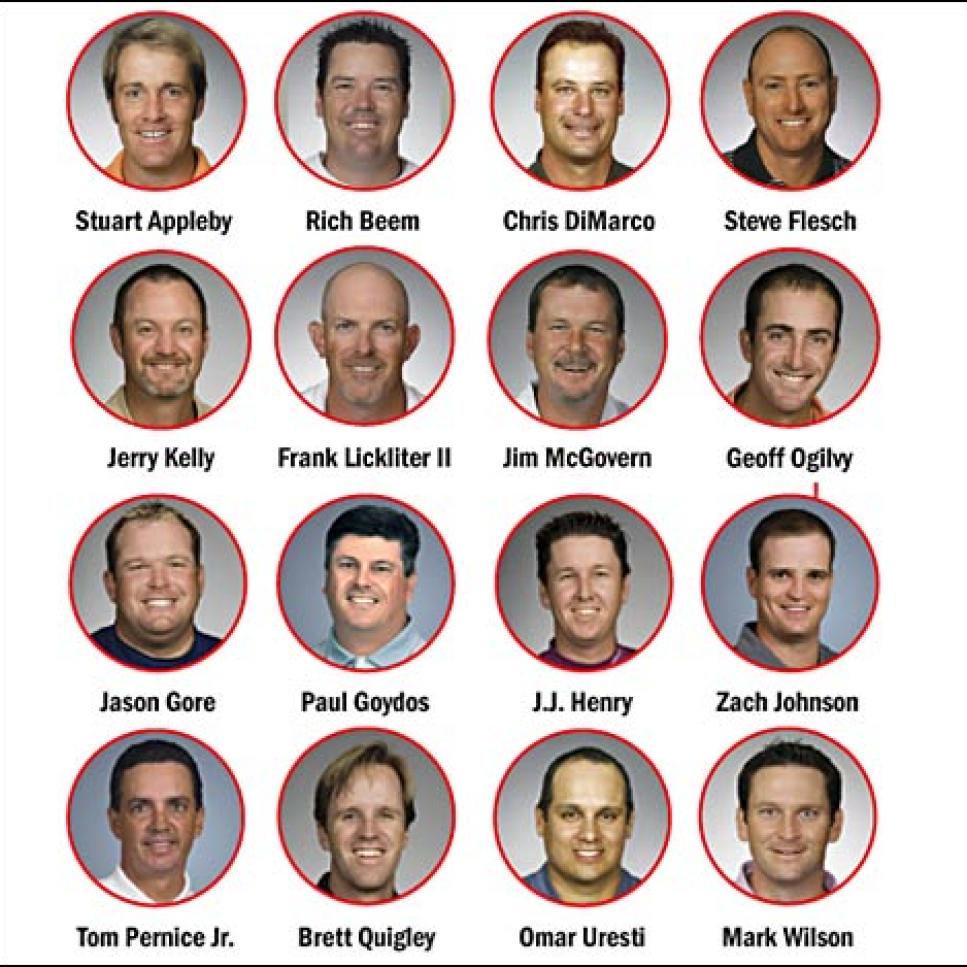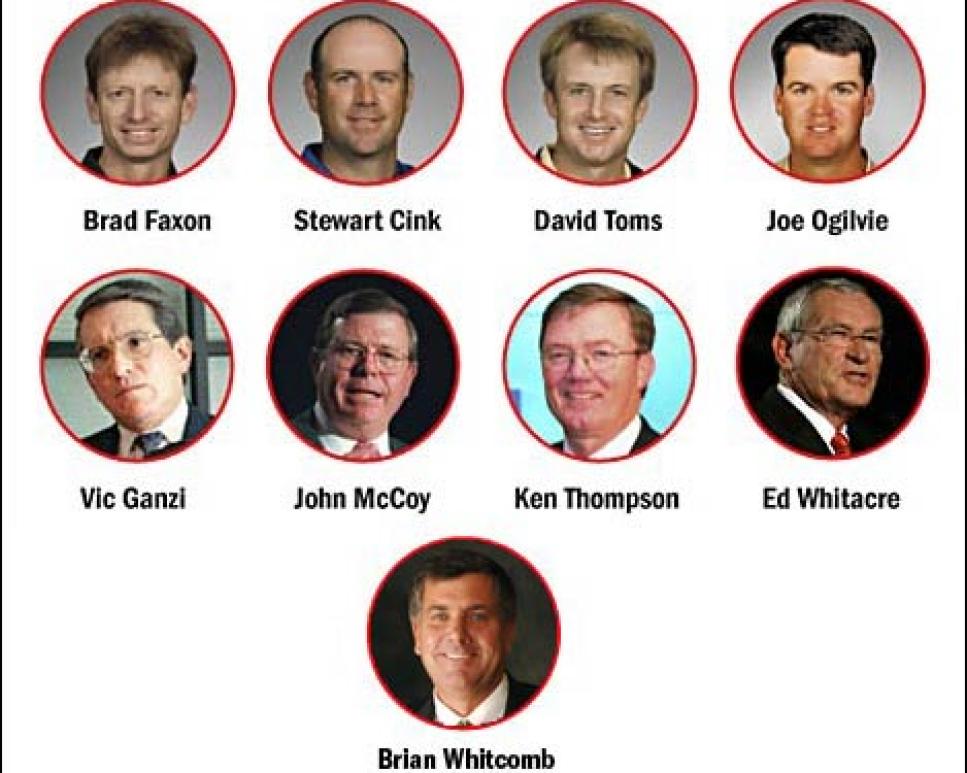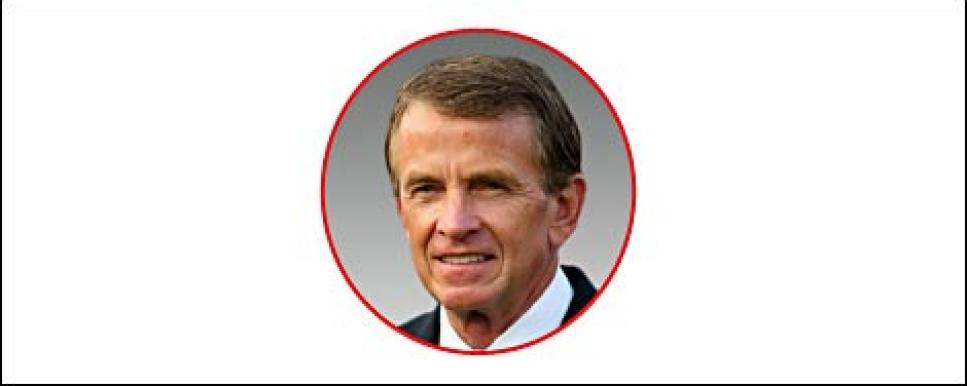News
What's Behind The Policy Board?

From drug testing to the new cut rule to the distribution of points for FedEx Cup playoff events, PGA Tour players have been more concerned with off-course news than on-course activity in 2008. Given the consternation the tour's rank-and-file has displayed over these decisions, one would think the commissioner's office in Ponte Vedra Beach, Fla., makes the rules, and that the players -- who are not unionized -- are forced unilaterally to go along. But that's giving Tim Finchem too much credit.
PGA Tour members rely on the Player Advisory Council (PAC) and the PGA Tour Policy Board to represent them on issues involving Finchem and his staff. The PAC, a 16-player committee, serves as a filter to the policy board, which is comprised of four players (Stewart Cink, Brad Faxon, Joe Ogilvie and David Toms) and four volunteer independent directors, all of whom are among the nation's most prominent businessmen and one member from the PGA of America. The latter includes Hearst Corporation president Vic Ganzi, who has replaced retiring Richard Ferris of United Airlines as chairman; Ed Whitacre, the former chairman and CEO of AT and financial executives John McCoy of Bank One and Ken Thompson of Wachovia. The PGA of America director is Brian Whitcomb, the association's president. The Player directors are consulted but have little input in the appointment of independent directors. This nine-man council sits at the right hand of Finchem and governs the tour.
Player directors almost exclusively decide competition-related matters. The independent directors defer to the players in these cases, except when they are called on to levy fines and select venues for tour events. But when it comes to non-competitive issues -- such as devising and underwriting the FedEx Cup playoffs or financing construction of the new clubhouse at the TPC Sawgrass -- the independent directors assume a more active role.
The policy board is the committee that approved the tour's much-scrutinized anti-doping plan last November. It will determine if any changes are forthcoming in the playoff's points system (provided the PAC submits recommendations it do so), and it created the floating-cut rule that was first implemented at the Sony Open three weeks ago and kept 19 players from weekend play at the Buick Invitational.
The decision to change the cut rule -- in effect, if more than 78 players qualify for the weekend, the official cut is lowered by a stroke -- began with discussions that go back three years. Tired of the slow play that was the result of expanded weekend fields, the PAC asked rules officials for feedback. They responded with the framework of the plan that ultimately was passed on to the policy board at its final meeting of 2007. The board agreed to implement the recommendations, and Finchem accepted the changes.
"The rule was passed to make a better tour," says Cink. "We knew it was going to ruffle some feathers, and obviously we've been called some horrendous names since Hawaii, but we believe it was a good decision. If we get to the end of the year and players are still making noise, we can always change it back. There are no egos involved. It was a business decision that [the board] made. We're standing by it."
This is how the system was designed to work, but sometimes there can be a communication breakdown. Players are notified of policy-board decisions online and through "green sheets" posted in locker rooms, but those are often ignored. That's when controversy and talk of a player union ensues. "After you do it for a while, you learn the players change, but you get the same kind of attitudes," says Davis Love III, who stepped down this year after a record third term on the board. "You have 20 to 30 guys who really want to help, and 20 to 30 guys that, no matter what you tell them, are just going to complain that everything is bad and nothing else is going to change. Everybody else just wants to hit balls and get better."
It takes a certain type of player to want to log the extra six-to-eight hours a week needed to sit on the boards and deal with disgruntled players. Brett Quigley is one of them. At the end of last season, council member Quigley was frustrated at the bureaucracy and the thanklessness that goes with being on the PAC. Recovering from knee surgery and adjusting to fatherhood (Quigley and his wife, Amy, have a 10-month-old daughter), the 12-year veteran was set to step down. But just before New Year's Day he received calls from Sid Wilson, the tour's vice president of player relations, and Faxon. "I felt I had given up on [caring about] the tour. Then they asked me to come back," Quigley says. "We had long talks about the tour, about sponsorships, about drug testing, whatever."
Now, not only is Quigley back on the PAC, he is running against Rich Beem and Zach Johnson for committee chairman, a position that will lead to a three-year term on the board in 2009.
Arnold Palmer and Jack Nicklaus, among others, helped devise this system of government when the Tournament Players Division split from the PGA of America in late 1968. Ferris, a member of Palmer's inner circle and chairman of United Airlines, was appointed to the Champions Tour Policy Board that was formed in 1985. He joined the PGA Tour board in 1992 and became chairman when Del de Windt, CEO of the Eaton Corporation, retired in 1993. The ultimate Alpha dog, Ferris was an efficient leader. "Let's put it this way: I tightened up the meetings considerably," he says. It was a different environment from the corporate boardroom for Ferris, but the two-tiered system of going through the PAC and the board provided a series of checks and balances that worked.
Ferris' boardroom skills were tested almost immediately during a player meeting in San Antonio in 1993 when two-thirds of the players signed a petition calling for a meeting to discuss hiring its own representative to oversee the player directors, in effect creating another layer of government and potentially weakening the policy board. To stave off the revolt, Ferris called a PAC meeting two hours before the player meeting and the issue never made it beyond that room. By getting the PAC behind him, Ferris was able to diffuse the player movement. "They just divide and conquer," says a tour player who attended the meeting. The following year Beman announced his retirement as commissioner and Ferris headed the search committee that ultimately elevated Finchem from deputy commissioner.
Because the independent directors make up the search committee, the players had little say in Finchem's appointment. Nor were they consulted in March 2006 when Finchem was granted a six-year contract extension. (The independent directors also make up the compensation committee, which determines Finchem's salary.)
Talk of a union or "Tournament Players Association" sprang up in 1998, when Danny Edwards, Larry Rinker and Mark Brooks led a movement seeking more accountability from tour headquarters. That revolt ultimately was squashed when Finchem, high level members of his staff and the policy board met in Oakville, Ontario, during the Canadian Open. The TPA could never gain traction after Finchem disclosed his salary and made a presentation highlighting the benefits of being a tour player.
A similar scenario could arise again, perhaps when somebody violates the tour's drug policy, because nobody is in place legally to represent the player as there is in other pro sports. "We don't have anybody in Jacksonville," says Ogilvie. "It has always been a league where we've had faith that the guys in Jacksonville will do what's best for the players. In this day and age we probably need a better conduit between the players and Jacksonville. The board could be that. The Player Advisory Council could be that, but not yet. I think there will be some change and we'll get there, but it has taken a little bit longer to turn around the aircraft carrier." There is a belief that the commissioner casts the deciding vote on all close issues. Veterans of the PAC and the policy board insist that isn't the case. Finchem is so good at working the system, so convincing in his presentations, so dogged in his preparation, however, by the time the balloting takes place, the vote is rarely tight. "Tim's a master at convincing people to do what he wants," says Tom Pernice Jr. Olin Browne adds that in all his time on the board and sitting in on meetings, Finchem never cast a deciding vote. "There's always a consensus," Browne says. Finchem clearly wields a lot of power -- though not as a dictator, as is commonly assumed, but as a behind-the-scenes dealmaker.
Pernice was mentored by Hal Sutton, who, like Ogilvie, had a close relationship with Finchem despite occasionally clashing with him in the boardroom. Pernice believes the boards need to be stronger and is never afraid to challenge authority. "Finchem [and the tour's braintrust] do whatever they can to dictate direction of the tour, and that's not always right," he says. "There's a [strong] perception by the players that they're not represented well. I told Tim, 'Five player directors would help. There would never be a tie.' "
The constant battle with bureaucracy drove Browne off the board and caused Quigley to attempt a sabbatical. "I had to get off," Browne said. "But don't misinterpret what I'm saying. Essentially, I support the tour and the board. But on some things we don't see eye to eye, which is what someone who thinks independently would say."
Commissioner Ogilvie?
Joe Ogilvie would make a good political candidate -- or even a potential successor to PGA Tour commissioner Tim Finchem. Ogivlie is well educated, business-minded, opinionated and a good communicator who is not afraid to debate the establishment on tough issues.
But after this year Ogilvie will step off the PGA Tour Policy Board to focus on his investment firm (Ogilvie Capital) and his playing career. "This is an important three years because in theory, Tim has five years left," says Ogilvie. "The next board will probably pick the next commissioner. I could probably take a year off in 2009 and go back in 2010. If I'm elected, I'd like to be involved in [choosing Finchem's successor]."
Ogilvie has no immediate desire to follow Deane Beman and replace Finchem at the end of the latter's current contract in 2012, but it's a job he would consider if approached. He certainly wouldn't mind the pay raise. Ogilvie won $1.3 million in 2007. Finchem, according to Sports Business Journal, earned $5.2 million in 2006. The p of commissioner is much more complicated than the last time a golfer took the post, when Beman moved from the golf course to the boardroom in 1974. "I have other interests," Ogilvie says. "But the other interests go hand in hand with what the commissioner needs to do."
At times Finchem and Ogilvie have appeared attached at the hip. Three years ago, when rain washed out the third round of the Players, the two men sat in front of a giant TV screen in the TPC Sawgrass clubhouse watching the NCAA tournament, discussing both basketball and moving the Players from the dicey late March weather into May. But in policy board meetings, Ogilvie always was the most direct player. "Ogilvie probably gave Finchem the hardest time," says Brett Quigley. "I don't know if it's his Duke background, but [Joe] would always come back at him."
Recently Ogilvie made headlines by lambasting Finchem and the tour's brass for not bothering to show up at the season-opening Mercedes-Benz Championship in Hawaii. Finchem reportedly responded with a blistering e-mail in return, but Ogilvie wasn't fazed. "I have tremendous respect for Tim," Ogilvie says. "I think he's extremely smart. I think he has done a very, very good job. But we're at a point with the tour in the last 10 years -- pretty much since Tiger came on board -- where we've grown so much that the old way of doing things is no longer valid. But it takes a different mentality to get away from the old and change."
THE GOVERNMENT OF THE PGA TOUR
As the only major sports league without a union, the members of the PGA Tour rely on a Player Advisory Council (PAC) and Policy Board to represent them on issues with PGA Tour commissioner Tim Finchem and his staff in Ponte Vedra Beach, Fla. This form of government was instituted in 1968 when the Tournament Players Division split from the PGA of America and hired USGA executive director Joe Dey as its first commissioner.
THE PLAYER ADVISORY COUNCIL (PAC)

Sixteen members, eight appointed by player directors from the PGA Tour Policy Board, eight elected by vote of the general membership -- all serve one-year terms. With about 60 percent of the membership turning in their ballots, this year's group was finalized at the Bob Hope Chrysler Classic and met at the Buick Invitational. This is the tour's "Congressional" level, the layer between the tour rank-and-file and the policy board. All complaints land here before going to the board, where, if important enough, they get discussed and ultimately voted on. "Most issues go through the PAC first," explains board member Stewart Cink. "A lot of times they die there. Other times they gain momentum." Rich Beem, Zach Johnson and Brett Quigley are running for chairman of the PAC, which will lead to an appointment on the policy board in 2009.
THE POLICY BOARD

Made up of four player directors serving three-year terms, one PGA of America director, and four volunteer independent directors comprised of leading businessmen who can serve until their 70th birthdays. The PGA Tour Policy Board includes Cink, Brad Faxon, Joe Ogilvie and David Toms. The PGA of America director is Brian Whitcomb, the association's president. Among the independent directors, Hearst Corporation president Vic Ganzi replaced retiring Richard J. (Dick) Ferris as chairman, with Ferris' seat taken by Ed Whitacre, the former chairman and CEO of AT&T. The two other independent directors, John McCoy (Bank One) and Ken Thompson (Wachovia), are stalwarts in the banking industry. Player directors have no say in the appointment of independent directors, who, as a group, name successors for retiring members.
THE COMMISSIONER

Tim Finchem sits in on PAC and Policy Board meetings and is in constant communication with the board. His job is to hire a staff and make sure the directives of the board are followed -- following the mantra that he works for the players, not the other way around. As Finchem quipped when his contract was extended by the independent directors, "I'm not sure [the players] jumped up and down, but I didn't hear any booing."